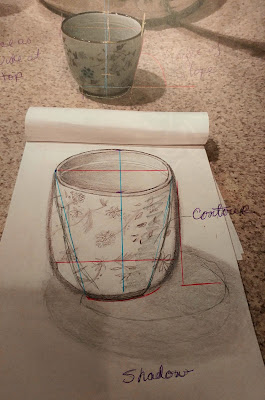My niece sent me a snapshot of her sketch of a small round
pot with the text “drawing round things is hard!”
I can see that she had trouble with this.
Why?
Well, its not uncommon to have trouble with any round
symmetrical object, or any asymmetrical object for that matter.
It can be hard to keep focused on what you actually see. The
brain has a tendency to “fill in the blank” even when there is no blank.
The problem here is with the “math”
Her “measurements”
don’t add up.
I can tell from the sketch that there were a lot of false
starts and more than a bit of erasing.
This is one reason some drawing teachers have students
practice drawing with a pen rather than a pencil. No erasure allowed. When we
erase and redraw over and over we tend to get frustrated, and things get
bigger. More “incorrect”.
I also see that she got distracted by the shadows and the
patterns on the vase. Distracted too soon by details she lost the overall shape
of the object.
If you look at the pot, you will notice that it is almost
twice as wide at the top than at the bottom. Also, at this angle, the opening
of the top of the pot is almost 1/3 the overall height of the pot.
What would have helped?
A couple of things.
One, a plumb or center line. Do not be afraid of putting
guidelines in your drawings and sketches. These should be light lines easily
erased. You can use a straight edge, but really any reasonably straight line
will do. Putting in a horizontal base line to indicate the bottom width and a
wider horizontal line for the top of the pot would also help. This would
automatically give you guidance for the correct slop. You can see that she has
her sides almost straight. The pattern got in the way.
Don’t worry about any pattern when sketching out the shape.
This is not important at this point.

The strong shadow also became too important. Because of the
focus on the cast shadow she did not discern the contour shadows.
I can see the growing frustration in this sketch.
Rather than going on and on. I think some sketch lines over her drawing will say it all. I have added a couple if guidelines to this sketch showing how easy the use of centerlines can help.
Relax.
Try again.



















